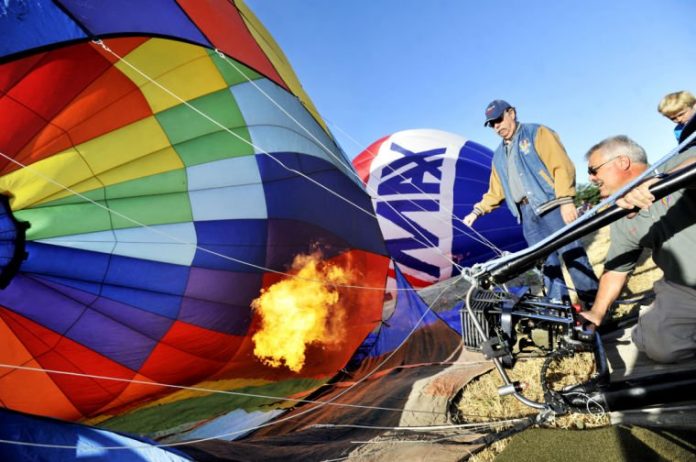
The 13th annual Wings of History Open House and Fly-by may be for the youth, but the hot air balloons that were being prepped early that morning were a piece of old-world technology that hasn’t changed much since the first flight more than 240 years ago.
Jeanne Anson is a 66-year-old hot air balloon pilot who currently resides in Brandon, South Dakota but annually brings her hot air ballooning experience back to her hometown airport. Her first balloon flight was in 1978 and she was hooked ever since. In 1982 she received her commercial ballooning license and has accrued more than 13,000 flight hours.
“It’s magic,” Anson said. “The magic of a balloon is that you can’t see the lifting gas. You’re like Oz, you land someplace and you’re surrounded by kids.”
She was right; each time the tethered balloons landed, there were kids running from the line to clamber into the basket, just for a chance to rise up with nothing but warm air and the physics of floating.
When the sun first began cresting the hills on Saturday morning, the balloon crews were already getting ready for the day, spreading tarps over the prickly ground and laying out the inflatable fabric portion of the balloon, called the envelope.
Anson explained that dawn was the best time of day for flight because the wind is calmest then. It is necessary policy to only fly in pristine weather conditions because balloons are the simplest of flying machines with only two directions of control: up and down. When airborne, the craft is at the mercy of the winds, drifting wherever the stiffest breeze is going.
Buoyancy, Anson explained, is the key principle at work. This is the same force that keeps boats afloat and helium balloons in the air. Less dense objects are pushed out of the way by denser fluids. In a hot air balloon, the hot air inside the balloon is less dense than the outside air.
With anywhere between 70,000 and 90,000 cubic feet of warm air inside the envelope, the pressure pushing up on the aircraft can lift up to 1,300 pounds worth of fabric, basket and passengers.
The pilot lifts the balloon by heating the air with a propane heater and then can drop back down to the ground by releasing the warm air out of a parachute valve at the top of the envelope.
The first flight in 1783 was in a balloon designed by brothers Joseph-Michael and Jacques-Etienne Montgolfier, built on the same principles as the models that were at the Open House on Saturday – albeit the straw-burning fire has been replaced with a much safer propane burner.
Anson left her own balloons with her business, Brandon Valley Balloon Adventures, but she used her skills to help oversee the three balloons lifting off from the San Martin Airport that morning. There were two balloons that lifted off in Morgan Hill, trying to make it to the airport, but never made touch down, due to the finicky nature of the winds.
Among the balloons lifting off from San Martin, there was the RE/MAX sponsored balloon piloted by Dave Wakefield, the Rubix team balloon piloted by trainee Lance Allen and his instructor Jennifer Parks, and an experimental balloon designed and made by its pilot, David Robinson. The experimental lifted off for an attempted flight to Morgan Hill while the two commercial models remained tethered at the field, giving rides to kids.
Wakefield, 55, came down to the event from Sacramento and travels to different ballooning events as the Northern Californian representative for the RE/MAX Balloon team. The RE/MAX balloon sports most of the new technologies available. It has side vents for turning, a temperature gauge, an altimeter, barometer (for the outside pressure) and a pressure gauge (for the inside pressure).
The hot balloons were not the only event at the open house; there were free small plane flights for children 8-17 with the Young Eagles program sponsored by the Experimental Aircraft Association (EAA), tours of the Wings of History museum, a radio-controlled model aircraft demonstration, and many other marvels. None of them, however, had quite the old-fashioned charm that goes with such a simple and unchanged mode of flying.
“This is my favorite part of the day,” said Patrick McGuinness, with Airport Operations for the county of Santa Clara. “The kids can get close to [the balloons], close enough to touch them.”













